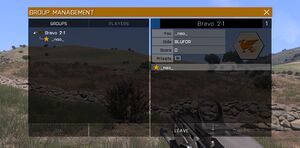Dynamic Groups – Arma 3
No edit summary |
Lou Montana (talk | contribs) m (Fix) |
||
| (36 intermediate revisions by 7 users not shown) | |||
| Line 1: | Line 1: | ||
<div class="float-right">[[File:arma3_DynamicGroups.jpg|thumb|center|alt= Dynamic Groups|Dynamic Groups]]</div> | |||
{{GVI|arma3|1.42}} | |||
{{TOC}} | |||
== Installation == | |||
To add the Dynamic Groups functionality to your mission do the following steps: | |||
Create a file in the mission root directory named [[Event Scripts#initServer.sqf|initServer.sqf]] (if you don't have it there already). | |||
Create a file in | This file is executed only on the server, when the mission starts. | ||
Into this file, copy & paste one of these two lines to make the server initialise the Dynamic Groups framework: | |||
<sqf> | |||
["Initialize"] call BIS_fnc_dynamicGroups; // initialises the Dynamic Groups framework | |||
// or | |||
["Initialize", [true]] call BIS_fnc_dynamicGroups; // initialises the Dynamic Groups framework and groups led by a player at mission start will be registered | |||
</sqf> | |||
== | Create another file in the mission root directory named [[Event Scripts#initPlayerLocal.sqf|initPlayerLocal.sqf]] (if you don't have it there already). | ||
The Dynamic Groups interface is tied to '''TeamSwitch''' action, and | This file is executed only by machines which have a human player when the mission starts (every machine but a dedicated server or a [[Arma 3: Headless Client|headless client]] - see [[hasInterface]]). | ||
Into this file, copy & paste one of these two lines to make a client/player initialise the Dynamic Groups framework: | |||
<sqf> | |||
["InitializePlayer", [player]] call BIS_fnc_dynamicGroups; // initialises the player/client side Dynamic Groups framework | |||
// or | |||
["InitializePlayer", [player, true]] call BIS_fnc_dynamicGroups; // initialises the player/client side Dynamic Groups framework and registers the player group | |||
</sqf> | |||
== Dynamic Groups Interface Access == | |||
The Dynamic Groups interface is tied to the '''TeamSwitch''' action, and its default keybind is {{Controls|U}}. | |||
== Additional Functionality == | |||
If you would like to register a group manually (same as a player clicking the '''CREATE''' button in the UI) use '''RegisterGroup'''. | |||
Please note that the leader you pass must be the actual leader of the given group, for example: | |||
<sqf> | |||
if (isServer) then | |||
{ | |||
private _group = group player; | |||
private _leader = leader _group; | |||
private _data = [nil, "Awesome Group", false]; // [<Insignia>, <Group Name>, <Private>] | |||
["RegisterGroup", [_group, _leader, _data]] call BIS_fnc_dynamicGroups; | |||
}; | |||
</sqf> | |||
{{Feature|informative|See [[BIS_fnc_dynamicGroups]] in the Functions Viewer for more sub-functions and their parameters.}} | |||
{{GameCategory|arma3|Editing}} | |||
[[Category:Introduced with Arma 3 version 1.42]] | |||
Latest revision as of 20:54, 27 May 2023
Installation
To add the Dynamic Groups functionality to your mission do the following steps:
Create a file in the mission root directory named initServer.sqf (if you don't have it there already).
This file is executed only on the server, when the mission starts.
Into this file, copy & paste one of these two lines to make the server initialise the Dynamic Groups framework:
Create another file in the mission root directory named initPlayerLocal.sqf (if you don't have it there already).
This file is executed only by machines which have a human player when the mission starts (every machine but a dedicated server or a headless client - see hasInterface).
Into this file, copy & paste one of these two lines to make a client/player initialise the Dynamic Groups framework:
Dynamic Groups Interface Access
The Dynamic Groups interface is tied to the TeamSwitch action, and its default keybind is U.
Additional Functionality
If you would like to register a group manually (same as a player clicking the CREATE button in the UI) use RegisterGroup. Please note that the leader you pass must be the actual leader of the given group, for example:
